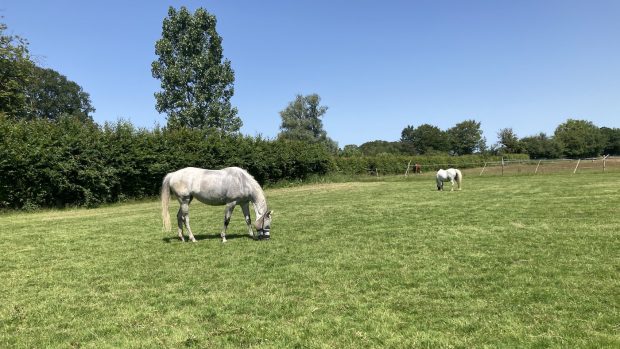As much as we look forward to the long evenings and warmer weather, summer can have its downsides too — especially if your horse or pony suffers from laminitis. Horse & Hound meets one owner to find out how he is managing the problem with his laminitis-prone polo pony
The horse: Petit Belle (Bella), 10-year-old 15.2hh polo pony
The problem: Laminitis
Symptoms: Zero-goal amateur polo player Tom Gordon-Colebrooke purchased Bella as a six-year-old in 2013.
“Her biggest immediate problem was her back, so we spent a lot of time correcting that with the chiropractor and working her in the winter in a Pessoa to strengthen her back muscles,” says Tom.
In spring 2015, Tom discovered Bella had laminitis.
“She’d just come back into work, and the spring grass was catching a lot of people out that year,” remembers Tom. “Bella is a thoroughbred sport horse — it just didn’t even occur to us that she might be susceptible to it.”
“Initially we thought it was some kind of foot soreness from shoeing or lameness. Laminitis was very low down on the list, but eventually we ruled everything out and laminitis was the only explanation.”
Tom did everything the vet recommended, and Bella had the whole season off.
“Her laminitis had knock-on effects to the strength of her horn, so she had to have remedial shoeing,” says Tom. “We went through about four different farriers and finally settled with Ben Benson in Swalcliffe who is brilliant. He straightened up the growth of the foot — which was weak and unconsolidated — and encouraged correct alignment.”
Continued below…

H&H question of the week: laminitis scare – what should I do?
Rick Farr B.Sc (Hons), B.V.Sc, MRCVS of Farr

Laminitis: how to spot the signs, plus a new treatment and ways to prevent it
Management strategy: Tom admits the summer season is a “bit of a nightmare” to manage.
“You can’t relax at any point in terms of her grazing routine,” he says, with it being closely monitored.
“We always have to consider how long she’s going to be out there, how long the grass is and whether she needs to be muzzled,” Tom adds. “She has extremely restricted grazing and is always in her own ‘starvation’ paddock.”
Immediately after Bella’s diagnosis all her hard feed was cut and her haynets were weighed to monitor her calorie and sugar intake. Once “the worst had passed” hard feed and supplements were introduced and included Dengie Healthy Hooves, Saracen’s Re-Leve, Equi-Jewel and Essential Balancer (for nutrients without sugar), and on the vet’s recommendation, Equitop Myoplast to help build back her muscle mass.
During her remedial farriery treatment, Bella was fed Farriers Favourite and had eucalyptus oil rubbed into her hooves daily.
Bella is also fed Zeolite, a natural detox supplement which binds toxins and flushes them out of the system.
“Even in the winter, we need to keep an eye on her,” says Tom. “She can be quite slippery and get her muzzle off. We feel her hooves daily and if at any point they feel warm she comes in straight away and goes on dry hay.”
“You can never relax about laminitis — it’s always there. This season Bella is the best in my string. She has problems but she’s worth it.”
If you are concerned about any summer ailments your horse is suffering from, please contact your vet
This article was first published in the 1 June 2017 issue of Horse & Hound magazine




